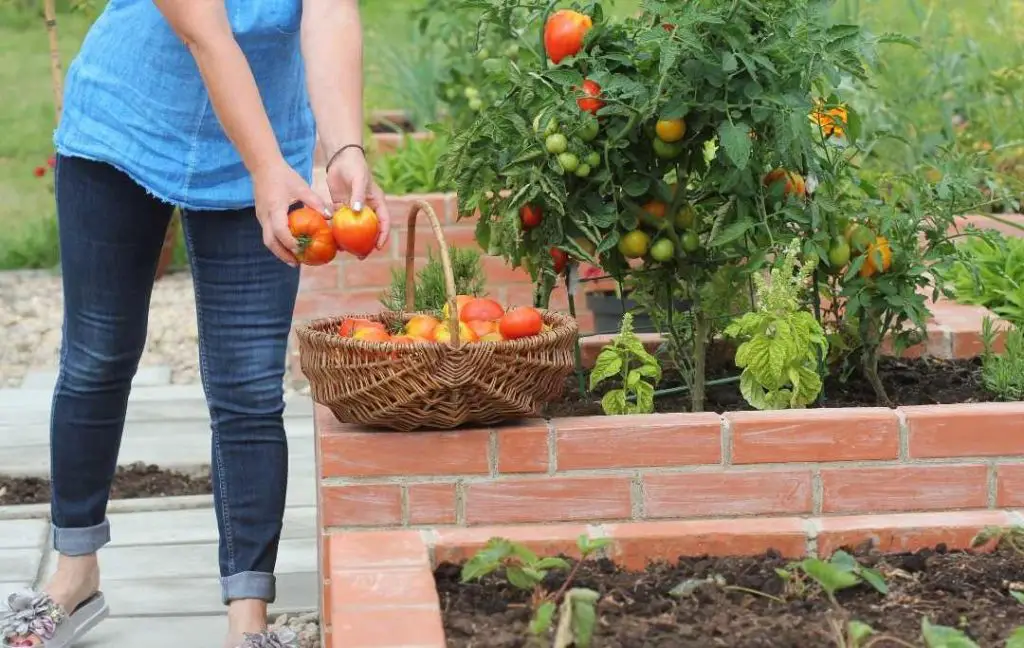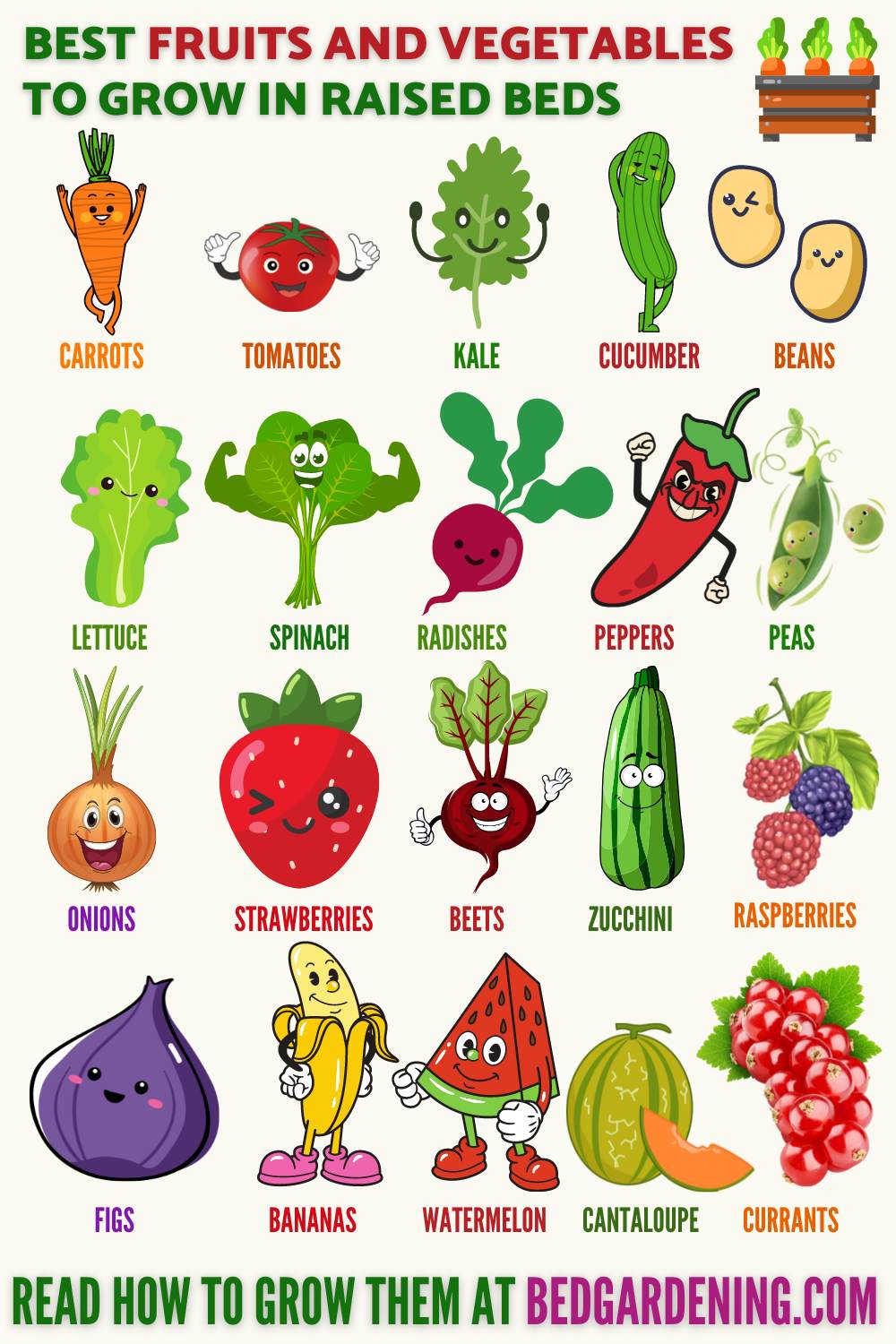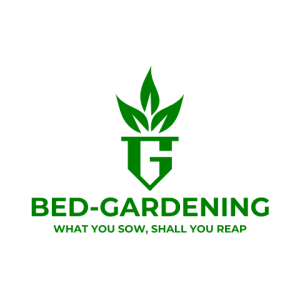Raised beds make gardening easier and you can get a fresh supply of fruits and vegetables. Raised beds are built from different materials such as concrete, wood, metal, and bricks.
But commonly pressure-treated wooden planks are used for this purpose. Old stock tanks, oversized grow bags and a swimming pool can also be used.
You can easily build 4 × 8 raised beds without having special skills in carpentry. You can also buy ready-made raised beds.

When you build your raised bed the next step is filling the raised bed with a high-quality potting mix. Never use garden soil because it is very compact and has fewer nutrients.
When you grow plants in raised beds then you can maintain the fertility of the soil very easily. Plants get all their nutrients and organic matter from the soil that’s why soil matters a lot rather than the size and type of the raised bed.
After preparing your raised bed now you have to decide what type of fruits and vegetables can easily grow in it. According to the size and depth of the raised bed, you should choose vegetables and fruits.
Here we are going to discuss with you some fruits and vegetables that can easily grow in the raised bed. You can select your favorite fruits and vegetables from the list. The choice is yours.

1- CARROTS
Carrots are deep-rooted vegetables that need loose and well-drained soil. Make sure the soil you are using has no stones and rocks otherwise the deep roots will not spread in the soil. In our square foot of space, you can plant 18 carrots.
The tiny seeds of carrots can be sown ¼ of an inch deep in the soil. After sowing the seeds, water them very gently otherwise they will wash away. When the germination process completes and the seeds sprout, you can thin the seedlings according to the space you have.
Read More: How To Grow Carrots In A Raised Bed?
2- KALE
One plant of kale needs one square foot of space to thrive well in the raised bed. A sunny location is not perfect for growing kale plants because they like cool weather. It is better to choose a partially shaded area.
Read More: How To Grow Kale In A Raised Bed?
3- CUCUMBER
Both bush and vining varieties of cucumber can be grown easily in raised beds. For vining varieties, you can install proper support for cucumber plants.
Support can make harvesting easier and your fruit will not be damaged due to its weight. The other advantage of a trellis is that your plants will get fresh air to breathe. The seeds of cucumber should be sown 6 inches apart and not more than 1 inch deep.
Read More: How To Grow Cucumber In Raised Beds
4- LETTUCE
Lattice is a cool weather crop, if you are living in a cold climate then it is a perfect choice for your raised bed. Tomatoes and peppers are good companions for lettuce; you can grow them together in your raised bed.
For growing lettuce, you can sprinkle the seeds in a thin line and gently cover them with a layer of soil. The seeds of lettuce are very tiny and light so water them very carefully otherwise they will be washed away.
When your lettuce plants start establishing you can start harvesting to thin the lettuce as it grows. For continuous production of lettuce, you can sow the seeds every two weeks according to the space you have in your raised bed. In this way, you will get fresh greens throughout summer long.
Read More: How To Grow Lettuce In A Small Greenhouse?
5- RADISHES
If you are looking for a vegetable that is very fast growing then you should select radishes for your raised bed. Radishes are companions alongside larger plants. Within 35 to 65 days or ready to harvest.
Dig a trench in your raised bed for sowing the seeds. After that, cover them lightly with a light layer of soil. Now your newly planted seeds need water to adjust to the new environment.
Read More: How To Grow Radishes From Scraps?
6- SPINACH
Lettuce and radishes are good companions of spinach. You can grow them together without having any problems. Spinach is like cool weather so you can start spinach early.
After harvesting, you can plant more spinach again in late summer or early fall. The seeds of spinach germinate within one week if you provide the right conditions.
Just like lettuce, you have to dig a tiny trench and sprinkle the little seeds and cover it with a light layer of soil. After sowing the seeds, water them very gently.
Read More: How To Grow Spinach In A Raised Bed
7- TOMATOES
This is a versatile plant and you can easily grow it in your raised bed. For a smaller raised bed, you should choose a smaller variety like cherry tomatoes.
If you have a small raised bed then you can choose a determinate variety. Tomato plants need proper support because of fruit. You must install tomato cages or trellises for this purpose.
You can also grow tomatoes from seeds. The young plants are also available from any local nursery or gardening store. When planting tomato plants you must leave 2 feet of space between each plant so they will get enough room.
Read More: How To Grow Tomatoes In A Raised Bed?
8- PEAS
Peas plants start producing within 45 days. You should choose a dwarf variety for growing in your raised bed because it doesn’t need any support.
If you choose a vining variety then you have to trail them. Growing peas is not difficult, you can directly sow the seeds in the cool season.
Read More: How To Grow Peas In Raised Beds
9- BEANS
Bush beans and pole beans are two types of beans. Both types of beans can easily grow in your raised bed. Bush beans are a smaller variety and don’t need any support.
On the other hand, if you talk about pole beans they need support. You must choose a sunny location for your raised bed. Plant your beans about 1 inch deep in the soil of your raised bed. There must be 6 or 7 inches of space between each plant.
Read More: How To Grow Beans In A Raised Bed Garden
10- ONIONS
If you are growing multiple vegetables in your raised bed then you must not plant beans and peas near onions. Onion sets are the best way of starting onions.
You can also plant the tiny bulbs in early spring. For starting with seeds, you should sow the seeds indoors 8 to 10 weeks before the last frost date. In this way, you will start your growing season earlier.
You can get all the information about the last frost date in your area from any local nursery. If you plant onions near kale, cabbage, broccoli, tomatoes, peppers, and cabbage then onions will act as a natural pest deterrent for these vegetables.
11- BEETS
Within 60 days your beets are ready to harvest. Beets need little space so you can easily grow them in a raised bed. Make sure the raised beds you are using for growing beets must be 12 inches deep.
When you are sowing the seed there must be a 3-inches space between each beet plant. For sowing seed, you have to make an inch-deep hole in the soil of your raised bed.
For healthy growth, you should maintain a frequency of water. Beets need regular water but you must avoid overwatering because soggy soil is not good for your plants. If you want a sweeter taste of beets then you should harvest them when they are smaller in size.
Read More: How To Grow Beets In A Raised Bed?
12- PEPPERS
Peppers like to grow in a hot environment. Tomato plants are the best companions of peppers. You can prepare your seedlings by sowing the seeds indoors 8 to 10 weeks before the last frost.
It is better to buy a young plant from a local nursery because growing from seeds can be a little finicky.
Read More: How To Grow Tons Of Bell Peppers?
13- ZUCCHINI
An ideal sunny location is perfect for growing zucchini in raised beds. You can also directly sow the seeds into your raised bed or container.
The soil in the raised bed warms earlier so you can start your growing season without waiting. To make your soil more healthy and rich you can add well-aged manure or compost.
Read More: How To Grow Zucchini In A Raised Garden Bed?
14- STRAWBERRIES
Strawberries are the best fruit for growing in raised beds. There must be 8 to 10 inches of space between strawberry plants. In this way, each plant will get plenty of room to grow.
During times of drought, your strawberry plants need more water so you should be careful. The soil of the raised bed, containers, or pots dries out very quickly so your plants need deep water regularly.
You should maintain a frequency of water for your strawberry plants. Fill your raised bed with a high-quality potting mix that contains all the essential nutrients that are needed by your strawberry plants.
Balance granular organic fertilizer contains nitrogen and other nutrients. You can apply this fertilizer annually in the spring.
Read More: How To Grow Strawberries In A Raised Bed?
15- FIGS
If your garden soil is very poor then you must plant your favorite fruits and vegetables in your raised bed. You can fill your raised bed with a potting mix. The easiest way of growing figs is from cuttings.
You must choose the variety according to the climate you are living in. The location of your raised bed must be sunny so you will get a healthy and higher yield. Keep the soil moist with regular watering.
16- BANANAS
Sunlight is very important for producing sweet bananas. You must choose a sunny location where your banana plants receive 12 hours of sunlight.
When you grow bananas in your raised bed then the large leaves will give an undeniable tropical oasis vibe in your garden or backyard. The right time to plant bananas is in spring and summer. To make your soil richer. You can add compost or manure a few days before planting.
17- WATERMELON
For growing watermelons in a raised bed, you must use a smaller variety like sugar baby watermelons. You need to install a trellis to provide proper support to your watermelon plants in your raised bed.
A sunny location is suggested for growing watermelon in your raised bed because with more sunlight your watermelon plants receive more juicy treats that will be ready for you in the summer season.
There must be 24 inches of space between each watermelon plant. After sprouting watermelon plant seedlings need 2 inches of water per week. When the fruit starts appearing on the vines then you can reduce the quantity of water to 1 inch per week.
Read More: How To Grow Watermelon In A Raised Bed?
18- CANTALOUPE
Raised bed gardening makes it possible to grow your favorite plants in nutrient-rich soil. When you grow plants in your raised bed, you must not use garden soil but use high-quality rich soil.
The suitable temperature for growing cantaloupes is between 95 to 100 degrees Fahrenheit. 8 to 10 hours of sunlight is essential for producing healthy cantaloupe.
If you want to start your growing season earlier then you can sow seeds 4 weeks before the last frost date. If you are living in a hot climate then you can directly sow the seeds outdoors in your desired raised bed.
Read More: How To Grow Cantaloupe Melons In A Greenhouse?
19- CURRANTS
This is a tasty fruit that can be used for decorating sweets and cakes. It is used for making jam and in other recipes you can also freeze them for a long time for future use.
Before planting the currents you must moisten and fertilize the soil of your raised bed. Make sure the soil is well-drained and rich in minerals so you will get a better crop.
20- RASPBERRIES
For growing red berries raised beds are an excellent place. If you use an elevated raised bed then it has better drainage which is essential for growing these juicy berries.
Make sure your raised bed must be built from untreated lumber. After choosing an ideal sunny location for your raised bed, fill it with well-drained loamy soil. Make your soil richer by adding compost. There must be 18 to 24 inches of space between each raspberry plant.
Regular watering and pruning are needed for the healthier growth of raspberry canes. For pruning, you must use sharp shears to remove the dead canes to encourage new growth.
Read More: How To Grow Raspberries In Raised Beds?
